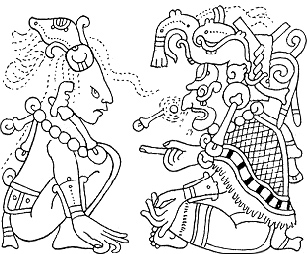
Mayan or Maya mythology is part in of Mesoamerican mythology and comprises all of the Maya tales in which personified forces of nature, deities, and the heroes interacting with these play the main roles. The legends of the era have to be reconstructed from iconography. Other parts of Mayan oral tradition are not considered here.

Qʼuqʼumatz was a god of wind and rain of the Postclassic Kʼicheʼ Maya. It was the Feathered Serpent that according to the Popol Vuh created the world and humanity, together with the god Tepeu. It carried the sun across the sky and down into the underworld and acted as a mediator between the various powers in the Maya cosmos. It is considered to be the equivalent of the Aztec god Quetzalcoatl and of Kukulkan, of the Yucatec Maya.

Popol Vuh is a text recounting the mythology and history of the Kʼicheʼ people of Guatemala, one of the Maya peoples who also inhabit the Mexican states of Chiapas, Campeche, Yucatan and Quintana Roo, as well as areas of Belize, Honduras and El Salvador.
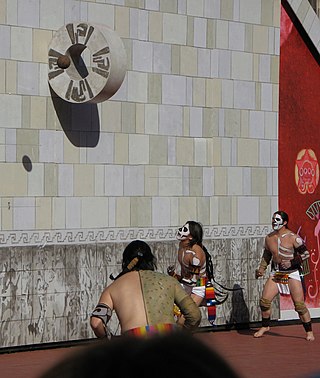
The Mesoamerican ballgame was a sport with ritual associations played since at least 1650 BC by the pre-Columbian people of Ancient Mesoamerica. The sport had different versions in different places during the millennia, and a modernized version of the game, ulama, is still played by the indigenous populations in some places.
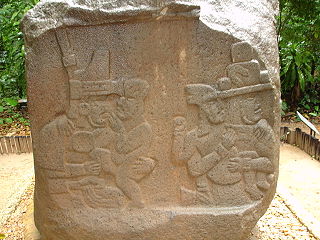
The Maya Hero Twins are the central figures of a narrative included within the colonial Kʼicheʼ document called Popol Vuh, and constituting the oldest Maya myth to have been preserved in its entirety. Called Hunahpu and Xbalanque in the Kʼicheʼ language, the Twins have also been identified in the art of the Classic Mayas. The twins are often portrayed as complementary forces.

Michael Douglas Coe was an American archaeologist, anthropologist, epigrapher, and author. He is known for his research on pre-Columbian Mesoamerica, particularly the Maya, and was among the foremost Mayanists of the late twentieth century. He specialised in comparative studies of ancient tropical forest civilizations, such as those of Central America and Southeast Asia. He held the chair of Charles J. MacCurdy Professor of Anthropology, Emeritus, Yale University, and was curator emeritus of the Anthropology collection in the Peabody Museum of Natural History, where he had been curator from 1968 to 1994.

The traditional Maya or Mayan religion of the extant Maya peoples of Guatemala, Belize, western Honduras, and the Tabasco, Chiapas, Quintana Roo, Campeche and Yucatán states of Mexico is part of the wider frame of Mesoamerican religion. As is the case with many other contemporary Mesoamerican religions, it results from centuries of symbiosis with Roman Catholicism. When its pre-Hispanic antecedents are taken into account, however, traditional Maya religion has already existed for more than two and a half millennia as a recognizably distinct phenomenon. Before the advent of Christianity, it was spread over many indigenous kingdoms, all with their own local traditions. Today, it coexists and interacts with pan-Mayan syncretism, the 're-invention of tradition' by the Pan-Maya movement, and Christianity in its various denominations.
Ancient Maya art comprises the visual arts of the Maya civilization, an eastern and south-eastern Mesoamerican culture made up of a great number of small kingdoms in what is now Mexico, Guatemala, Belize and Honduras. Many regional artistic traditions existed side by side, usually coinciding with the changing boundaries of Maya polities. This civilization took shape in the course of the later Preclassic Period, when the first cities and monumental architecture started to develop and the hieroglyphic script came into being. Its greatest artistic flowering occurred during the seven centuries of the Classic Period.

Hun Hunahpu "One Hunahpu" is a figure of Late Postclassic Maya mythology whose name connects him to the XXth day of the day count, Hunahpu. His tale is part of the early-colonial "Popol Vuh" manuscript. According to this source, Hun Hunahpu is the father of the Maya Hero Twins, Hunahpu and Xbalanque. He is also the father of the twins' half-brothers, the patrons of artisans and writers, Hun-Chowen and Hun-Batz. Hun Hunahpu is paired with his brother, Vucub-Hunahpu "Seven Hunahpu". These two brothers of the generation preceding that of the hero twins were tricked into the Dark House by the lords of the Underworld (Xibalba) and sacrificed. Hun Hunahpu's head was suspended in a trophy tree and changed to a calabash. Its saliva impregnated Xquic, a daughter of one of the lords of Xibalba. She fled the Underworld and conceived the Twins. After defeating the Underworld lords, the twins recovered the remains of their father and their father's brother, but could not resuscitate them.
Vucub-Caquix is the name of a bird demon defeated by the Hero Twins of a Kʼicheʼ-Maya myth preserved in an 18th-century document, entitled ʼPopol Vuhʼ. The episode of the demon's defeat was already known in the Late Preclassic Period, before the year 200 AD. He was also the father of Zipacna, an underworld demon deity, and Cabrakan, the Earthquake God.
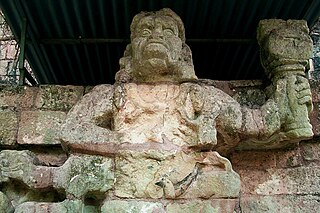
Among the Classic Mayas, the howler monkey god was a major deity of the arts—including music—and a patron of the artisans, especially of the scribes and sculptors. As such, his sphere of influence overlapped with that of the Tonsured Maize God. The monkey patrons—there are often two of them—have been depicted on classical vases in the act of writing books and carving human heads. Together, these two activities may have constituted a metaphor for the creation of mankind, with the book containing the birth signs and the head the life principle or 'soul', an interpretation reinforced by the craftsman titles of the creator gods in the Popol Vuh.

Like other Mesoamerican peoples, the traditional Maya recognize in their staple crop, maize, a vital force with which they strongly identify. This is clearly shown by their mythological traditions. According to the 16th-century Popol Vuh, the Hero Twins have maize plants for alter egos and man himself is created from maize. The discovery and opening of the Maize Mountain – the place where the corn seeds are hidden – is still one of the most popular of Maya tales. In the Classic period, the maize deity shows aspects of a culture hero.

The traditional Mayas generally assume the Moon to be female, and the Moon's perceived phases are accordingly conceived as the stages of a woman's life. The Maya moon goddess wields great influence in many areas. Being in the image of a woman, she is associated with sexuality and procreation, fertility and growth, not only of human beings, but also of the vegetation and the crops. Since growth can also cause all sorts of ailments, the moon goddess is also a goddess of disease. Everywhere in Mesoamerica, including the Mayan area, she is specifically associated with water, be it wells, rainfall, or the rainy season. In the codices, she has a terrestrial counterpart in goddess I.

The pre-Columbian Maya religion knew various jaguar gods, in addition to jaguar demi-gods, (ancestral) protectors, and transformers. The main jaguar deities are discussed below. Their associated narratives are still largely to be reconstructed. Lacandon and Tzotzil-Tzeltal oral tradition are particularly rich in jaguar lore.

God L of the Schellhas-Zimmermann-Taube classification of codical gods is one of the major pre-Spanish Maya deities, specifically associated with trade. Characterized by high age, he is one of the Mam ('Grandfather') deities. More specifically, he evinces jaguar traits, a broad feathery hat topped by an owl, and a jaguar mantle or a cape with a pattern somewhat resembling that of an armadillo shell. The best-known monumental representation is on a doorjamb of the inner sanctuary of Palenque's Temple of the Cross.
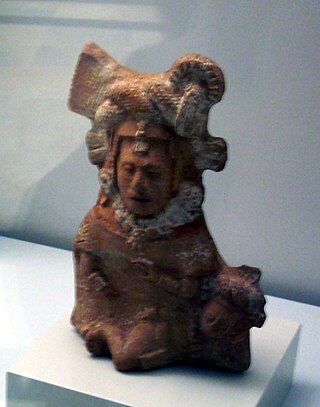
Goddess I is the Taube's Schellhas-Zimmermann letter designation for one of the most important Maya deities: a youthful woman to whom considerable parts of the post-Classic codices are dedicated, and who equally figures in Classic Period scenes. Based on her representation in codical almanacs, she is considered to represent vital functions of the fertile woman, and to preside over eroticism, human procreation, and marriage. Her aged form is associated with weaving. Goddess I could, perhaps, be seen as a terrestrial counterpart to the Maya moon goddess. In important respects, she corresponds to Xochiquetzal among the Aztecs, a deity with no apparent connection to the moon.

The Maya death gods known by a variety of names, are two basic types of death gods who are respectively represented by the 16th-century Yucatec deities Hunhau and Uacmitun Ahau mentioned by Spanish Bishop Diego de Landa. Hunhau is the lord of the Underworld. Iconographically, Hunhau and Uacmitun Ahau correspond to the Gods A and A' . In recent narratives, particularly in the oral tradition of the Lacandon people, there is only one death god, who acts as the antipode of the Upper God in the creation of the world and of the human body and soul. This death god inhabits an Underworld that is also the world of the dead. As a ruler over the world of the dead, the principal death god corresponds to the Aztec deity Mictlāntēcutli. The Popol Vuh has two leading death gods, but these two are really one: Both are called "Death," but while one is known as "One Death," the other is called "Seven Death." They were vanquished by the Hero Twins.
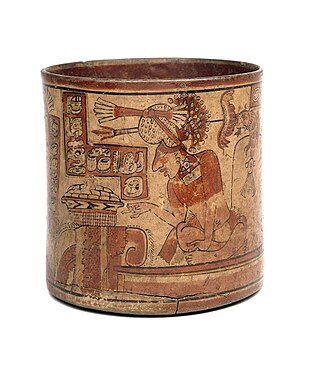
The Fenton Vase is the name of a famous ancient Maya vase or cup that was excavated from the archeological site of Nebaj in the western Guatemala highlands. It is known for its intricate painting and historical record of the Maya elite. The vase was acquired by the British Museum in 1930, which named it after a donor. Other examples of Maya ceramics include the Princeton Vase.
The Codex Style is one of the most celebrated and recognizable styles of Ancient Maya art. It was first identified in 1973 by Michael Coe in the book The Maya Scribe and His World, in which the PSS was discovered. Coe called it “codex style” because he believed that the authors of the designs on the vessels were the same scribes who had painted or written the codices and that the paintings on the vessels imitated the images found within them.












